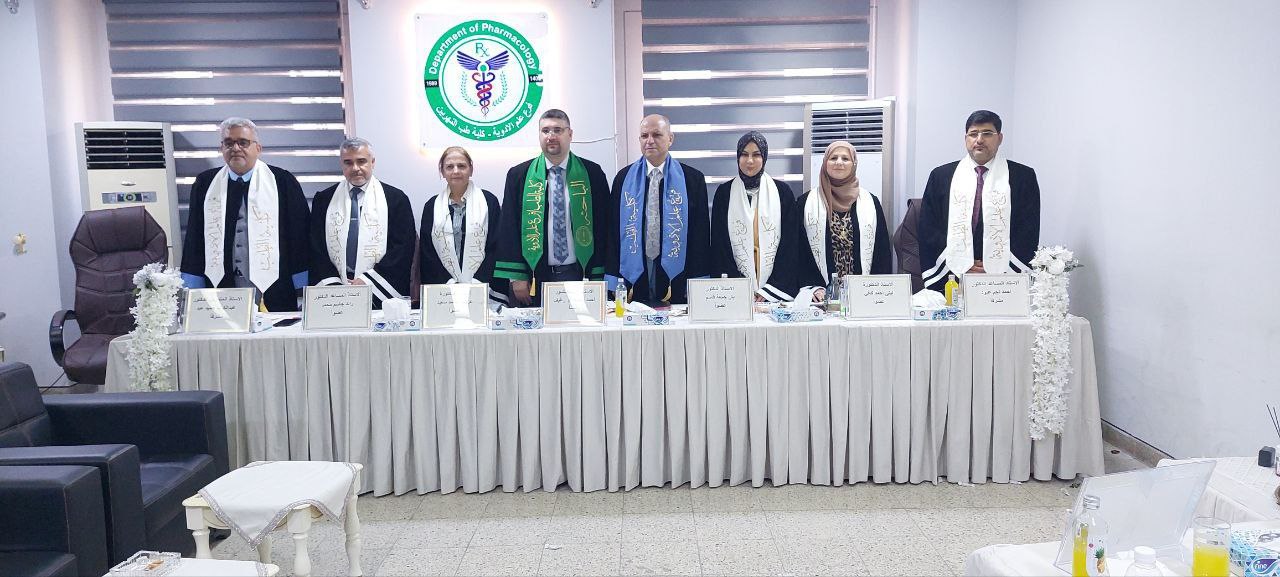
On Wednesday, May 15, 2024, PhD candidate Omar Saleh Abdulqader from the Department of Pharmacology successfully defended his dissertation titled:
**"Study The Effect of Topically Applied Fusidic Acid Loaded-Silver Nanoparticles as Gel Dosage Form on Burn-Induced Model in Rats"**
Burn injuries are multifaceted and painful events with varied effects at both local and systemic levels, impacting multiple organs in addition to the skin. Burns can significantly damage various tissues, including muscles, bones, blood vessels, and skin, leading to subsequent pain and poor wound healing.
Therefore, the primary goal of burn treatment is to initiate immediate healing and epithelialization after damage to prevent bacterial invasion.
Sodium fusidate is a universal topical antibiotic for treating skin and soft tissue infections. However, challenges such as drug resistance, inadequate skin penetration, localized discomfort, and suboptimal efficacy persist.
Enhancing the therapeutic efficacy of sodium fusidate can be achieved by integrating it with other agents and polymers, using a biocompatible carrier that supports cell growth and proliferation.
Nanodrug delivery systems play a crucial role in treating chronic infections and wound healing. They are well-established for delivering active ingredients to wound tissues, such as growth factors, antibiotics, antioxidants, and DNA, thereby stimulating cell proliferation, angiogenesis, collagen deposition, and inhibiting microbial growth.
**Study Objective:** To develop a novel gel formulation of silver nanoparticles loaded with sodium fusidate to protect and enhance the release of sodium fusidate in burn wounds in rats.
**Methods:** The methodology followed two lines of approach; first, formulating a gel of silver nanoparticles loaded with sodium fusidate and measuring various pharmaceutical parameters such as spherical diameter, polydispersity index, and pH. Second, conducting laboratory work on 30 male rats divided randomly into 5 groups with 6 rats each (treatments applied twice daily).
The animal groups included: healthy rats (non-burned, untreated), burns without treatment, burns treated with 1% sodium fusidate gel, burns treated with silver nanoparticle gel, and burns treated with 1% sodium fusidate-loaded silver nanoparticle gel.
Rats were sacrificed 14 days post-burn, with photographic monitoringof wound closure, blood samples collected for white blood cell counts, and skin biopsies analyzed using histological techniques to identify neutrophils, macrophages, and lymphocytes. Additionally, immunohistochemical analysis was performed to detect levels of tumor necrosis factor-alpha (TNF-α), interleukin-10 (IL-10), and vascular endothelial growth factor (VEGF).
**Results:** The particle size and polydispersity index of the silver nanoparticles loaded with sodium fusidate were measured at 668.2±0.2 and 0.567±0.002, respectively. The pH value was determined to be 6.2±0.05.
Morphological wound healing showed interesting results for the new formulation of sodium fusidate-loaded silver nanoparticles, with rapid wound closure by day 7 and almost complete healing by day 14. Bacterial growth was significantly lower in samples treated with sodium fusidate-loaded silver nanoparticles (50±6×105) and showed a larger inhibition zone (1.3 mm) compared to other tested drugs. Histopathological examination of the treated groups revealed significant reductions in neutrophils, macrophages, and lymphocytes, with marked increases in epithelial regeneration, angiogenesis, and collagen fibers compared to others on day 14. The treated groups also exhibited significant decreases in TNF-α levels on day 14, while VEGF levels significantly increased, indicating near-complete wound healing.
**Conclusions:**
The developed formulation of sodium fusidate-loaded silver nanoparticles was more effective in healing burn wounds as it accelerated wound closure and enhanced epithelial regeneration and anti-inflammatory responses. It also enhanced the antibacterial effect of sodium fusidate.
The examination committee consisted of:
- Prof. Ahmed Rahma Ali (Chair)
- Prof. Aroob Mohammed Said (Member)
- Prof. Banan Jumaa Qasim (Member)
- Prof. Lubna Ahmed Kafi (Member)
- Assoc. Prof. Raed Jasim Mohammed (Member)
- Emeritus Prof. Abdul Kareem Hameed Abdul (Member and Supervisor)
- Assoc. Prof. Ahmed Najim Aboud (Member and Supervisor)
The dissertation was successfully accepted with a grade of Very Good.

|